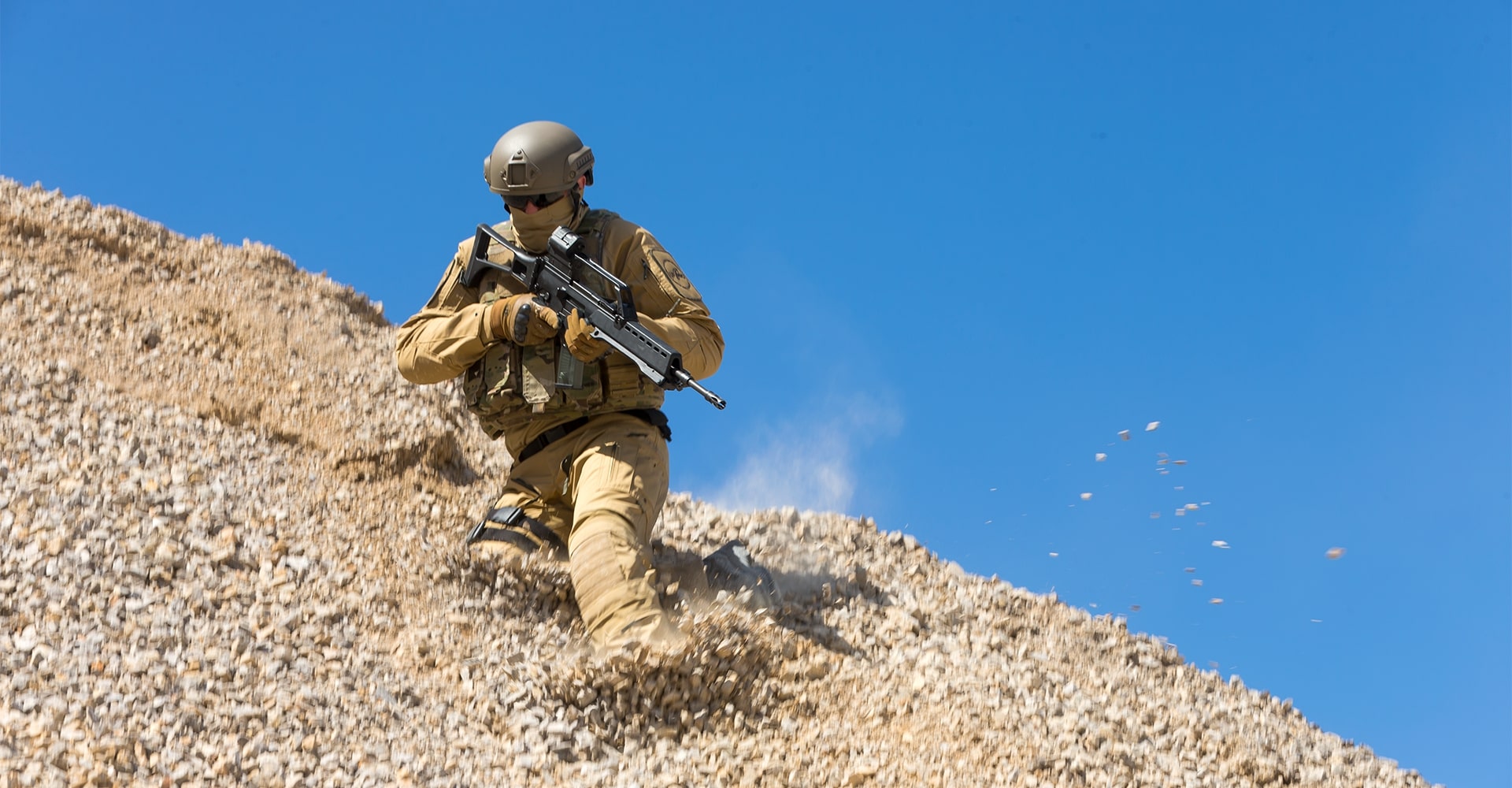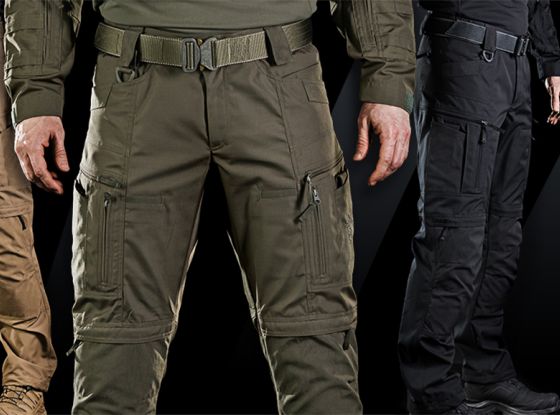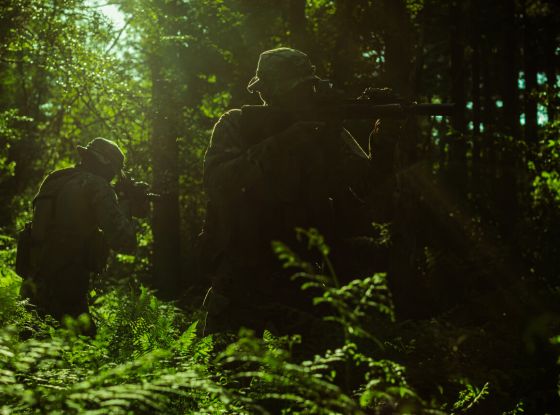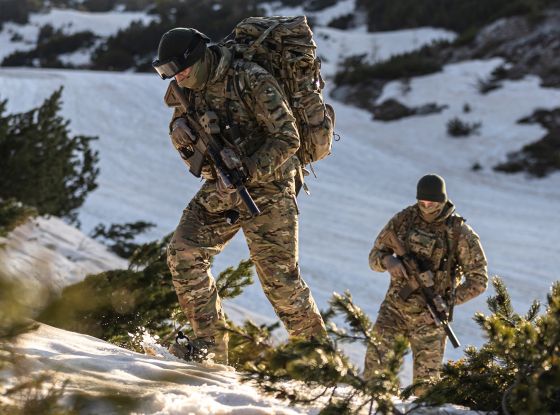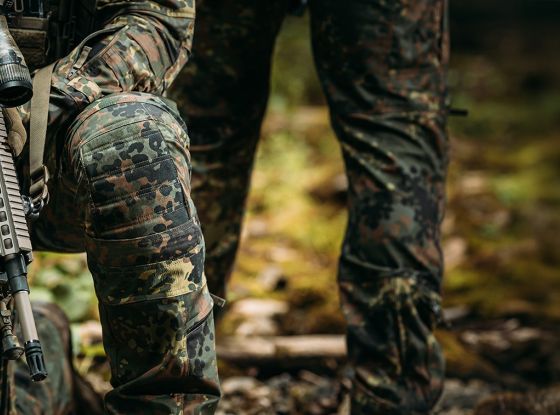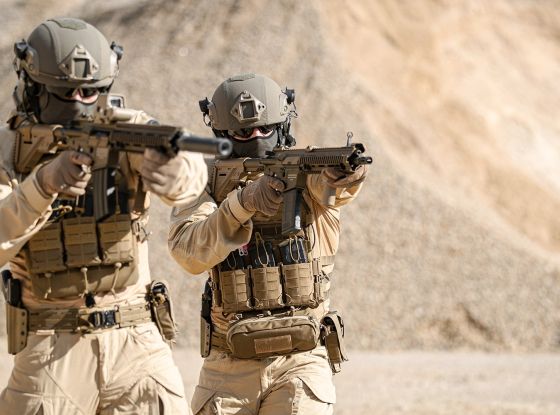Marsikatere hlače delujejo taktično: ojačana kolena, trpežen material, nekaj dodatnih žepov – in na pogled so videti kos vsaki nalogi. Ampak pravi test pride šele kasneje. Takrat, ko si ure in ure na kolenih, v znoju, blatu, v mokri travi. Ko se plaziš, tečeš, ko vlečeš ranjenca, padeš v reko ali te premoči nevihta. Takrat šivi popustijo. Kolenčniki zdrsnejo. Tkanina razpade.
Vsake hlače niso ustvarjene za takšno obremenitev. In ravno tam se prave bojne hlače ločijo od vseh ostalih.
In this blog post:
Kaj Pomeni, da so Hlače Narejene za Teren?
Obremenitve na terenu niso naključne. Niti enkratne. Obremenitve so konstantne in prihajajo iz vseh smeri: iz okolja, iz naloge in tvojega lastnega gibanja. Če želiš razumeti, kaj pomeni, da so hlače res pripravljene na teren, si predstavljaj tole:
Džungelski Teren
Plaziš se skozi gosto podrast, plevel in ostro travo, ki ti z vsakim gibom trga hlače. Zrak je zadušljiv, poln vlage in mrčesa. Znojiš se, potem pa prečkaš reko ali te zajame tropski naliv – in v sekundi si moker do kože.
Bojne hlače morajo odvajati vlago dovolj hitro, da preprečijo drgnjenje, razjede in razvoj plesni. Hkrati pa morajo prenesti trganje, vlečenje in neprestano drsenje čez rastlinje. Več o izbiri prave opreme za tropske razmere najdeš v našem Vodiču o tem, na kaj moraš biti pozoren pri izbiri taktične opreme za vroče vreme. V članku Poliamid vs. bombaž - kaj je najboljše za tropske razmere pa lahko preveriš, zakaj je prava izbira materiala v tropih tako zelo pomembna.
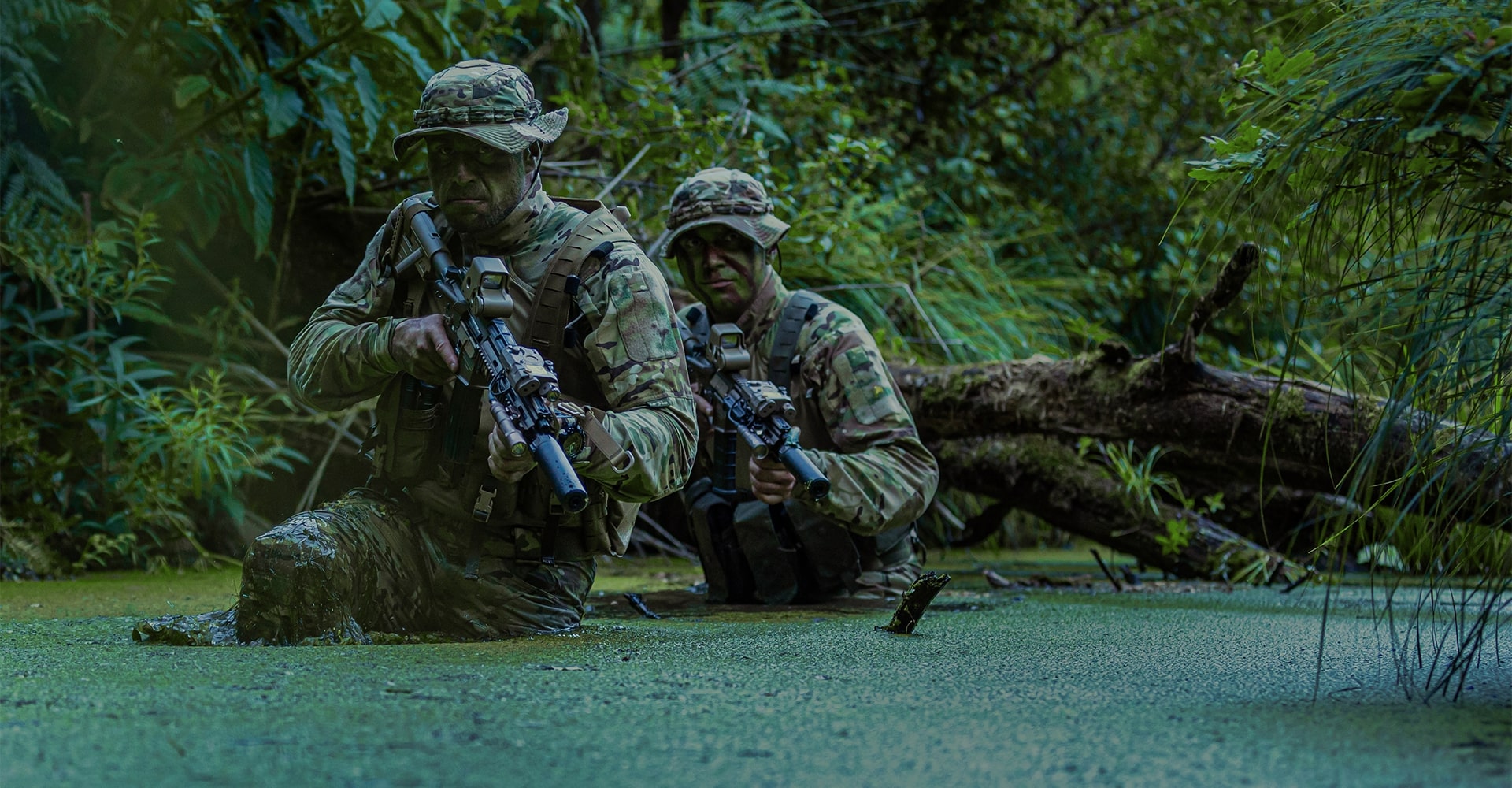
Sneg, Led in Mraz
Sneg se nabira na kolenih in škornjih. Led otrdi tkanino – če ta ni raztegljiva ali toplotno učinkovita, postanejo tvoji gibi togi in neodzivni. Ko poklekneš na zmrznjeno podlago ali razpokan beton, pride do trenja, ki raztrga vsak šibkejši material. A tudi v takih pogojih moraš ostati gibljiv. Topel. In zaščiten pred poškodbami. Zakaj je ustrezna zimska oprema tako ključna? Preveri v našem članku: Kako lahko zimska taktična oprema odloča o uspehu ali neuspehu misije.
Veter, Prah in Visoka Nadmorska Višina
Visoko v gorah ali na odprtem terenu oster veter reže skozi vsak šiv in odprtino. Droben prah in pesek se zažirata v zadrge, obrabljata premaze in blokirata zračenje. Tkanina mora dihati, ščititi telo in hkrati ohranjati funkcionalnost – brez kompromisov.
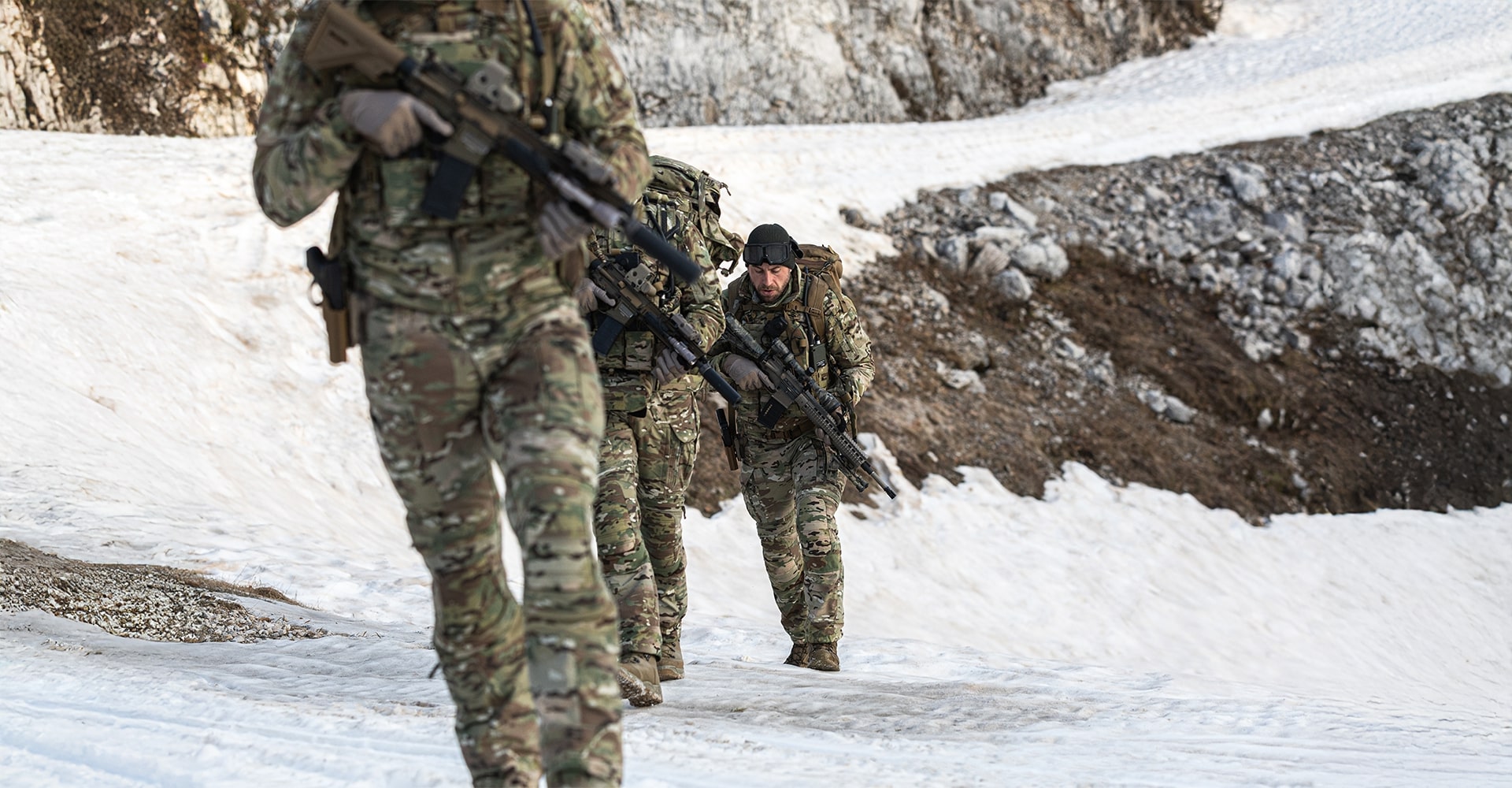
Urbano Okolje
Poklekneš na razbit beton, zdrsneš v zaklon čez steklo in grušč. Tečeš, plezaš, preskakuješ ovire in pri tem tvoje hlače drsijo čez vsako grobo površino in vsak oster rob. Hlače te morajo ščititi, obenem pa nositi več kot 20 kilogramov opreme na pasu in stegnih. Vsak tvoj gib napenja šive, razteza panele, obremenjuje celotno konstrukcijo. Če tkanina tukaj popusti, je odpovedala vsa tvoja oprema.
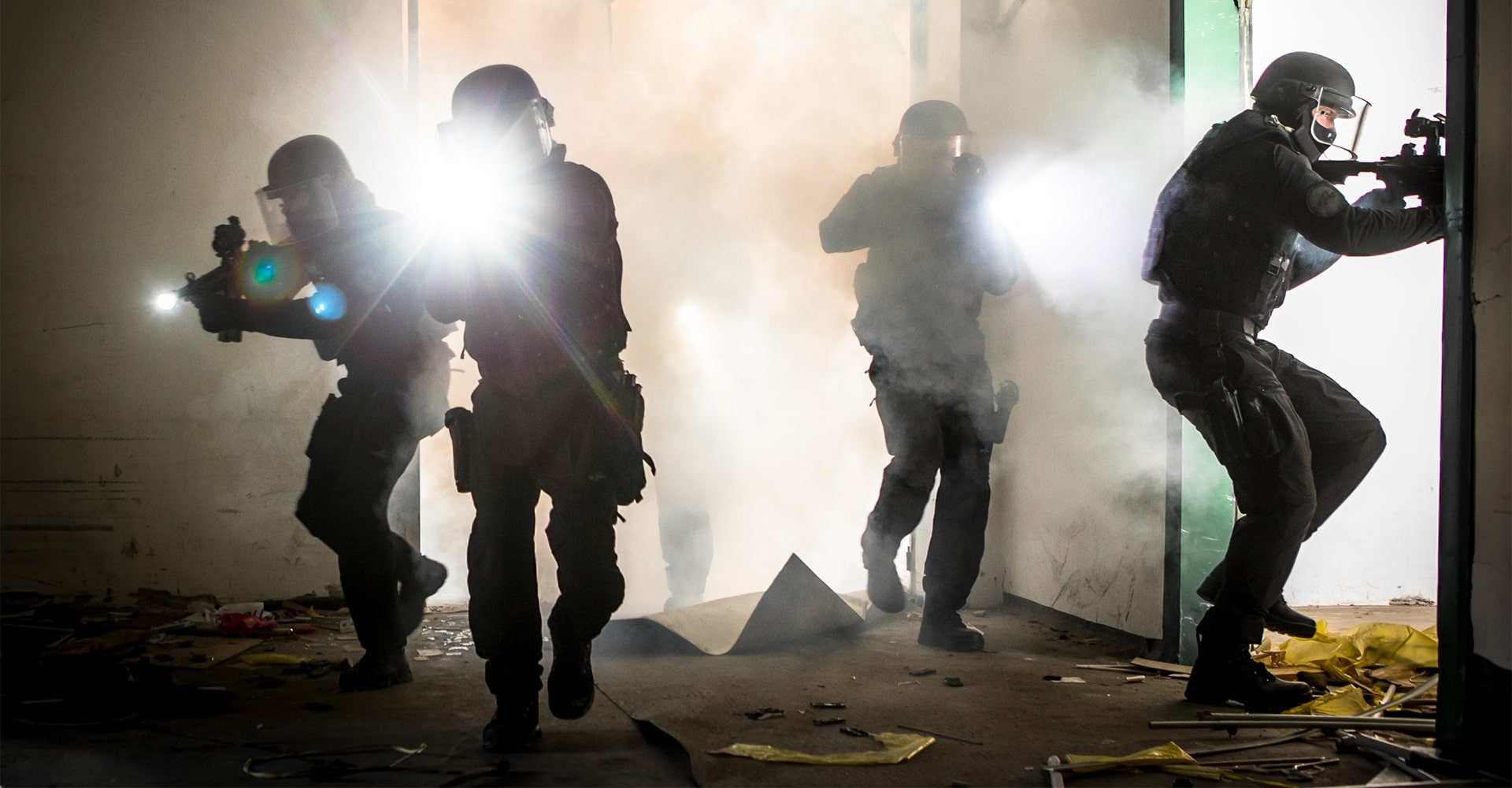
Gibanje Brez Premora
Vse se dogaja zelo hitro – iz ležečega položaja greš v počep, iz teka preideš v plezanje, iz prevala v preskok. Vsak premik pa pritiska na sklepe ter razteza in obremenjuje šive in tkanino. Bojne hlače se morajo ves čas prilagajati. Takoj. Brez zatikanja. Brez izjem.
PRIJAVI SE IN DOSTOPAJ DO ŠE VEČ TAKŠNIH VSEBIN
Vnesi svoj e-poštni naslov in prejmi najnovejše informacije o taktičnih temah neposredno v svoj nabiralnik.
Prijavljaš se na naše e-novice, od katerih se lahko kadarkoli odjaviš. Preberi več o tem v sekciji “zasebnost“.
Anatomija Bojnih Hlač, ki Prenesejo Vsak Teren
Če želiš vedeti, ali so bojne hlače res narejene za teren – ne pa zgolj za katalog – preveri naslednje ključne elemente.
Tkanina, ki Zdrži in Sodeluje s Tabo
Pozabi na modne izraze kot sta »ripstop« ali »tactical«. V resnici ni važno, kaj piše na etiketi. Važno je, kako se material obnaša takrat, ko si na kolenih.
- Mešanice, kot sta NyCo (najlon-bombaž) in Polycotton, združujejo zračnost in vzdržljivost.
- Cordura® ali podobni ojačitveni materiali ščitijo kolena, sedežni del in spodnje hlačnice.
- Zunanja plast mora zdržati tudi, ko je mokra, in se posušiti, še preden začutiš drgnjenje.
Test: Podrgni kolenski del hlač ob grobo površino. Se začne trgati? Muckati? Če tkanina dobro drži, si na pravi poti.
Več o razliki med materiali si lahko prebereš v člankih o tkaninah Ripstop, Polycotton in NyCo. Kako pa na najbolj izpostavljenih delih deluje Cordura®, si preberi v prispevku: Cordura® Materials Breakdown.
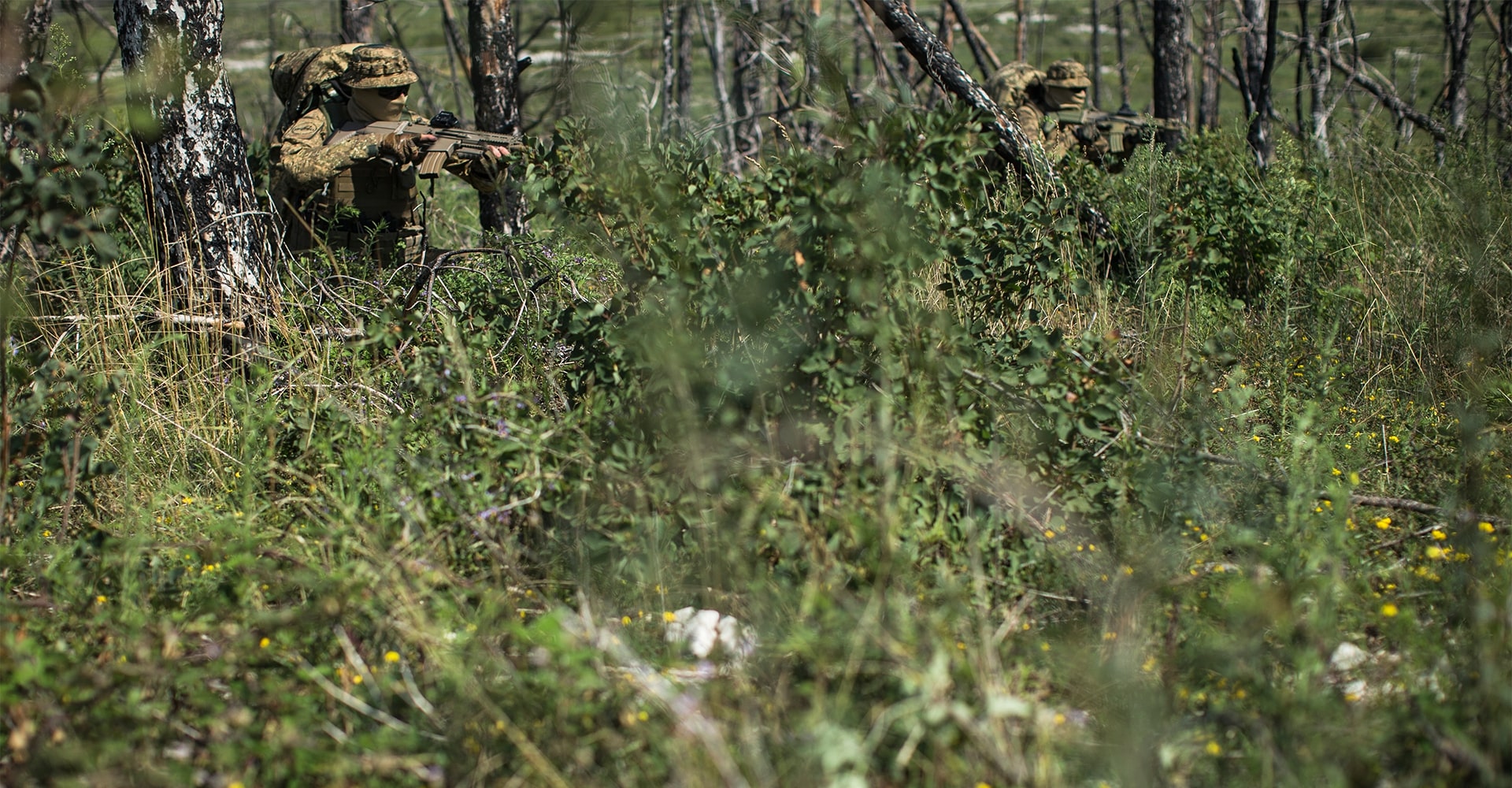
Šivi, ki ne Popustijo, ko gre Zares
Vsak gib vpliva na šive; počep, razteg, nizek tek, nenaden zasuk. In če konstrukcija ne zdrži, se bodo hlače razparale točno tam, kjer si najmanj želiš. Pomembni elementi so:
- Trojni šivi na najbolj obremenjenih delih.
- Ojačitve z bartack šivom na pasnih zankah in vogalih tovornih žepov – tam, kjer šivi najbolj trpijo.
- Vložek v razkoraku (gusset), ki razporedi pritisk in omogoča več gibanja.
Test: Preveri notranjost hlač po nekaj pranjih. Če se niti že cefrajo, je to za hlače res slaba napoved.
Kroj, ki Sledi Tvojemu Gibanju
Bojne hlače te ne smejo omejevati. Prave hlače se premikajo s tabo – na vsakem koraku, skoku ali spustu. Tukaj so ključne specifike:
- Predoblikovana kolena, prilagojena za gibanje v strelskih položajih, pri plazenju ali prehodih čez ovire.
- Strateško nameščeni raztegljivi paneli na kolenih, bokih in v sedežnem delu – za svobodno gibanje tam, kjer ga najbolj potrebuješ. Povsod drugje mora konstrukcija ostati čvrsta. Zakaj se ta raztegljivi material obnese tudi pod pritiskom, preveri v članku Breaking Point: Schoeller Stretch Material.
- Prilegajoč kroj, ki hlače drži ob telesu brez zategovanja. Manj odvečnega materiala pomeni tudi manj možnosti za zatikanje pod opremo.
Test: Spusti se v počep. Naredi izpadni korak. Zavrti se. Če se hlače vlečejo, ti drsijo ali omejujejo gibanje, potem niso narejene za teren.
Vgrajeni Kolenčniki, ki Ostanejo na Svojem Mestu
Dober sistem za zaščito kolen ni samo žepek za vstavljanje podloge. Prava rešitev ostane tam, kjer mora biti – in deluje, ko pristaneš na beton, ko zdrsneš na koleno ali dlje časa klečiš na trdni podlagi. Zato izberi:
- Večslojno zaščito, ki združuje mehko podlogo za udobje in trdo školjko za zaščito pred udarci.
- Enostavno in hitro vstavljanje brez komplikacij. Najpomembnejše pa je, da kolenčniki ostanejo na mestu – tudi med tekom, plazenjem ali prehodom čez ovire.
- Notranjo mrežico, ki zmanjša potenje in draženje pri dolgotrajni nošnji.
Če si moraš med nalogo popravljati kolenčnik, ker se premika – potem je sistem odpovedal. In s tem tudi tvoje hlače.
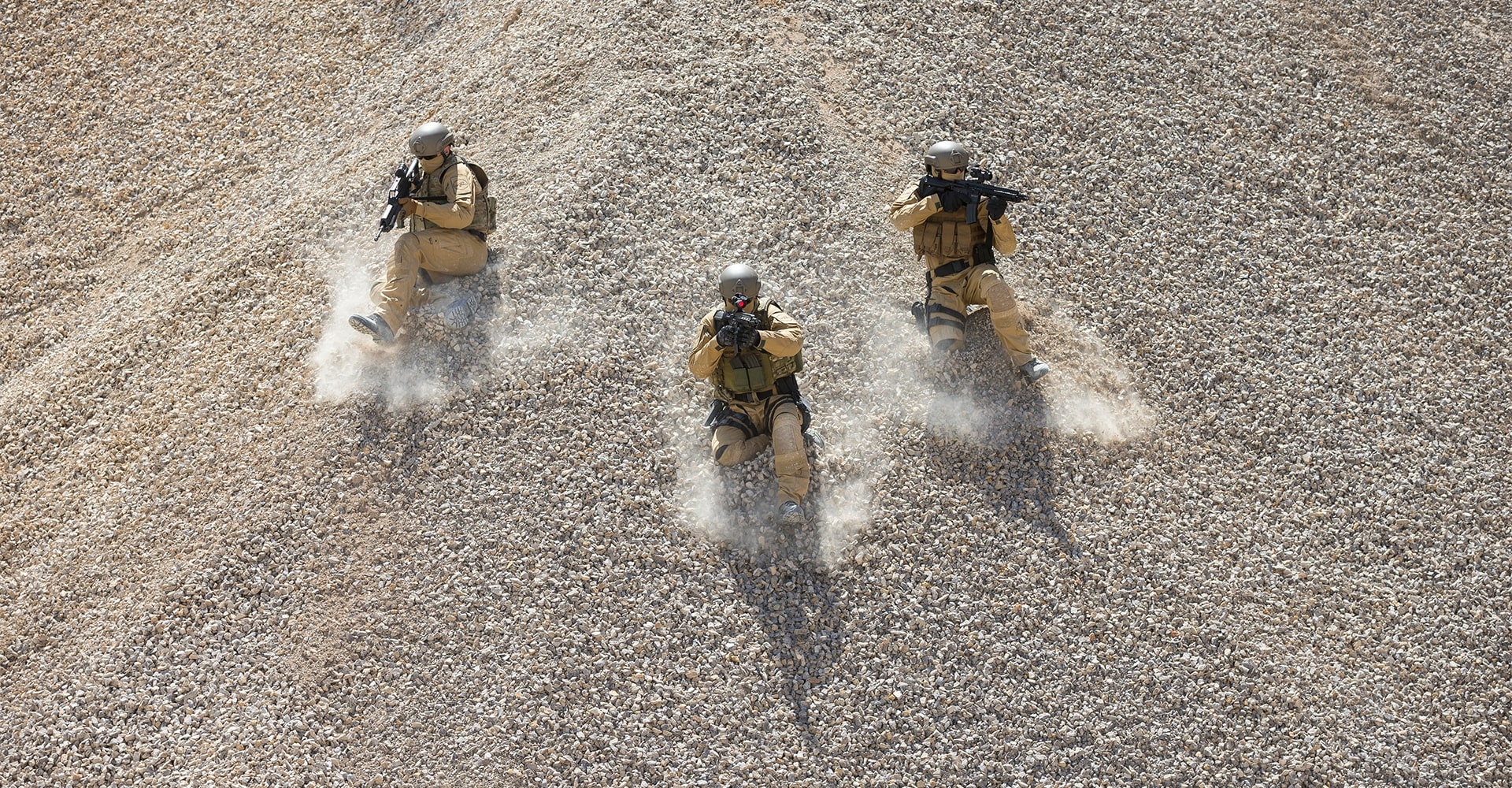
Funkcionalni Dodatki, ki Imajo Svoj Namen
Vsak detajl na bojnih hlačah mora imeti svojo funkcijo. Brez navlake. Samo rešitve, ki delujejo na terenu.
- Tovorni žepi z dvojnim dostopom in pokrovom – za hiter dostop in zaščito vsebine.
- Odtočne odprtine v žepih na hlačnicah – kadar deluješ v vodi ali v visoki vlagi.
- Zanke za pripenjanje hlač na škornje – da hlače zanesljivo ostanejo na svojem mestu tudi v blatu, visoki travi ali med plazenjem.
- Prilagodljiv pas, ki se optimalno prilega tudi pod ploščni nosilec.
- Zadrge in zapirala, ki nikdar ne zatajijo – niti v pesku, prahu ali snegu.
Vse to mora delovati zate. Nikoli proti tebi. Če želiš preveriti, kaj vse še moraš upoštevati pri izbiri novih bojnih hlač, si preberi naš članek: What to Look for When Buying Tactical Pants.
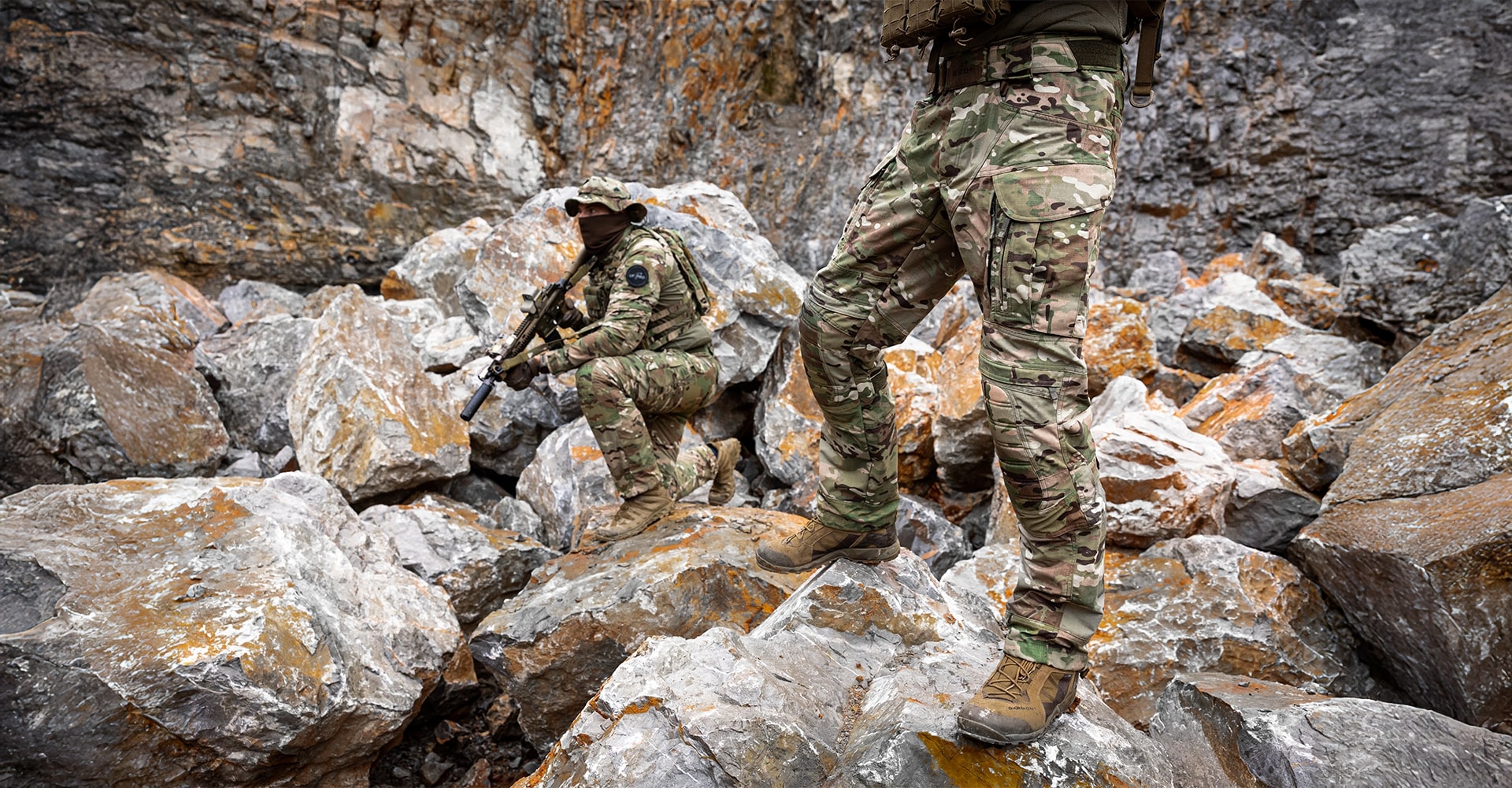
Ko Hlače ne Zmorejo več
V resnici ne potrebuješ laboratorija, da bi lahko presodil, ali so bojne hlače primerne za teren ali ne. Dovolj je, da prepoznaš naslednje opozorilne znake:
- Tkanina hitro bledi, se začenja muckati ali mehčati.
- Zadrge se zatikajo in ježki ne držijo več.
- Šivi se cefrajo že po nekaj dneh na terenu.
- Raztegljivi paneli po pranju ostanejo raztegnjeni.
- Kolenčniki med gibanjem drsijo, se obračajo ali začnejo tiščati.
- Na opremo računaš, ko si utrujen, pod pritiskom ali izpostavljen. Zadnje, na kar bi moral misliti, je razparan razkorak, kolenčnik, ki ti leze v čevelj, ali žep, ki se ne zapre. Ko ti hlače ne sledijo več, izgubiš fokus, čas – in svojo zmogljivost.
Kako pa lahko sam poskrbiš za daljšo življenjsko dobo svojih hlač? Preveri v prispevku Kako podaljšati življenjsko dobo bojnih hlač.
Hiter Test: so Tvoje Hlače še kos Nalogi?
Potrebuješ le pet minut. In malo prostora.
- Povleci pasne zanke. Držijo čvrsto ali se trgajo proč od blaga?
- Počepni. Se kolena in sedežni del upognejo brez odpora ali stiskanja?
- Pretegni raztegljive panele. Se takoj vrnejo v prvotno obliko ali ostanejo raztegnjeni?
- Preveri ojačitve. Opaziš muckanje, nitke ali obrabo?
- Vstavi kolenčnik. Ostane na mestu tudi med hojo, klečanjem in vstajanjem?
Če tvoj par bojnih hlač pade na enem ali več teh testov, potem ni narejen za dolgotrajno delo na terenu.
Zaključek
Od mokrih džungel do zaledenelih cest – vsak teren na tvoji opremi pušča svoj pečat. In samo tiste hlače, ki lahko prenašajo tovrstne udarce dan za dnem, si zaslužijo mesto v tvoji rotaciji. Ko znaš prepoznati pravo tkanino, trdno konstrukcijo in funkcionalne rešitve, se lahko giblješ z več samozavesti in z manj motenj. In če se pri svojem trenutnem paru bojnih hlač že sprašuješ, ali bodo zdržale … potem odgovor verjetno že poznaš.
Želiš še več?


